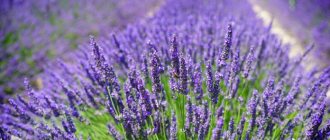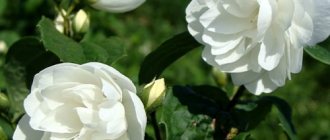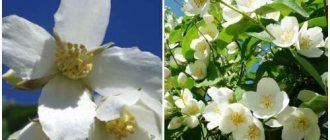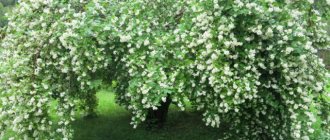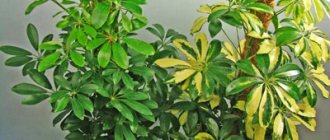Mock orange is an amazing flowering shrub that can become a real decoration for any garden. At the peak of its flowering, it turns into a snow-white cloud. There are varieties with different flowering times, which allows you to enjoy the beauty and aroma from May to August. They also distinguish: low, medium and tall varieties, which allows you to create a unique composition on the site.
The plant is often called jasmine due to its visual similarity and the pleasant subtle aroma of the flowers. Still, jasmine and mock orange are different plants that belong to different botanical families and require different care.
The bush got its name due to the soft core and hard wood from which mouthpieces and pipes for smoking pipes were made. The Latin name of the plant is philadelphus in honor of the Egyptian king Ptolemy Philadelphus.
Features of growing mock orange
The growing process is not particularly difficult. It is important to pay special attention to the plant during the first three years of growth. The future fate of the plant and its appearance depend on the correct planting, care and care.
How and when to plant mock orange
This is a light-loving plant that prefers to grow in open areas. The splendor of flowering depends on the degree of lighting. In the shade there will be few flowers, they will be small, and the shoots will be very long.
As for the soil, the ideal option would be to make your own substrate. To do this, you need to take leaf soil, sand and humus in a ratio of 3:2:1. During the first growing season, this mixture will provide the plants with the necessary nutrients. If the soil at the planting site has low water permeability, additional drainage will be required. Stagnant water can destroy the plant.
Recommendations for landing:
- For planting you will need to prepare a hole. Its size must correspond to the volume of the root system of the seedling that will be used. As a rule, it is enough to dig a hole 60 centimeters in diameter and the same depth.
- If you plant mock orange in groups, you need to take into account that the crowns of the bushes are quite voluminous. Because of this, the distance between seedlings should be about 1.5 meters. When creating a hedge, it is recommended to reduce the distance to 70 centimeters.
- It is advisable to lay a drainage layer at the bottom of the hole to prevent water stagnation.
- After this, the seedling is placed in the hole and covered with a previously prepared substrate of sand, humus and leaf soil.
When planting, special attention should be paid to the root collar. It is important that it is immersed in the ground no more than 2 centimeters. Otherwise, rotting and, as a result, death of the bush is possible.
Planting mock orange can be done in early spring, before the first buds appear, or in the first half of autumn. In any of the options, the chance of seedling survival is quite high, since the plant is not whimsical and has excellent frost resistance.
How to care for mock orange
This is not a whimsical plant that can grow in natural conditions without human intervention. Still, to get a truly beautiful and lushly flowering bush on your site, you need to put in a little effort.
Watering
The shrub does not have high drought resistance; therefore, it requires timely watering. In hot summers it is necessary to water at least once every two days. In the absence of sufficient moisture, the leaves quickly droop. Under normal conditions, watering is necessary 1-2 times a week. In this case, you need to pour 2-3 winds of water under the tree trunk.
After each watering, it is recommended to loosen the soil near the mock orange and remove weeds. To save time, you can mulch the soil near the trunk with shavings or straw. This technique will also reduce the frequency of watering, since the moisture will not evaporate so quickly.
Top dressing
For normal growing season and abundant flowering, it is necessary to add nutrients in a timely manner. It is important to feed the plant in early spring using purchased nitrogen-based complex fertilizers or make a solution of mullein (1:10) and pour it under the bush.
The second time you need to fertilize at the end of the flowering period. To do this, potash (1 tablespoon) and phosphate (2 tablespoons) fertilizers are diluted in a bucket of water and poured under the bush. Instead of mineral fertilizers, you can use ash. It is enough to distribute 2 cups of ash evenly under the bush and cover it a little with earth. Before wintering, it is advisable to spread compost or humus in a 5-centimeter layer around the tree trunk.
Trimming
Pruning is an important stage of care, since in mock orange flower buds are laid on annual shoots. To do this, after the flowering stage, you need to cut off all the branches with dried inflorescences. This will allow nutrients to be sent to strengthen the shoots. In addition, pruning will create a beautiful shape for the crown of the bush. In this case, it is necessary to cut off weak or damaged branches.
Even neglected and unkempt bushes can be restored with spring pruning. Before sap begins to flow, cut off all branches at the root. You only need to leave a few of the strongest shoots up to 30 centimeters long. It is from these stumps that the mock orange will be reborn. New young shoots will allow you to form a beautiful decorative crown.
Wintering
Preparing for winter does not require much effort, since most species are winter-hardy. But when purchasing a young seedling, it is worth clarifying the degree of frost resistance of this variety.
In very severe frosts, the above-ground part of the mock orange can freeze completely. But with the onset of spring, the root system quickly restores the bush and produces new young shoots. Because of this, before the onset of cold weather, it is recommended to carry out a little insulation of the roots. To do this, it is enough to mulch the area near the trunk with a layer of peat, straw or dry grass. With the arrival of spring, the mulch needs to be removed.
The best varieties of mock orange
To create many magnificent varieties, foreign and domestic breeders have used the Lemoine mock orange (Philadelphus x lemonei).
In 1884, Lemoine received the “Avalanche” , which is traditionally translated as “Avalanche” (people sometimes call it “Strawberry” ) - a low shrub up to 1.5 m tall with thin brown shoots covered narrow small (up to 2 cm long) light green leaves. It blooms at the beginning of the 2nd decade of June very profusely with simple white flowers up to 3 cm in diameter, which are formed in groups of 1-3 on short axillary shoots and gracefully color the branches falling down, while emitting a delicate strawberry aroma. Unfortunately, this variety cannot withstand frosts below -150C. N.K. Vekhov, one of the most talented domestic collectors of the 30s of the XX century, having improved it, received the variety “Snow Avalanche” , which also has a very graceful bush no more than 1.5 m in height with gracefully curved branches falling down and covered with small leaves up to 4 cm long, semi-double flowers up to 3 cm in diameter with a crenate curved edge of the petals and a strong strawberry aroma. If you approach this bush during the flowering period and close your eyes, it seems that you are standing next to a huge basket filled with freshly picked strawberries. The flowering is so abundant that the branches fall in a continuous white avalanche at your feet, which fully justifies the name of the variety. In addition, this variety is more winter-hardy than the Lemoine variety. “Snow Avalanche” is the earliest flowering variety of mock orange; it blooms immediately after the wild mock orange. The variety takes root well with summer green cuttings. The best time to take cuttings is the period when the young shoots, bent into a ring around the finger, do not break, and the leaves are already well formed. This variety is recommended for landscaping in the central temperate zone of Russia.
| Avalanche | Mock orange Lemoine |
Of the foreign varieties bred by Lemoine, which have proven themselves well in the Moscow region, it is also necessary to note the Pyramidal variety - a tall bush with large annual branches fan-shaped at the top of the bush and white large semi-double flowers up to 4-5 cm in diameter with weak aroma. Flower clusters are located along the main shoot for more than 80 cm. It blooms for a long time, usually finishing the flowering of mock orange varieties. Recommended for wide use in landscaping in central Russia.
“Mont Blanc” variety, which forms low (about 2 m) fluffy bushes up to 2 m in diameter with double white flowers up to 5 cm in diameter, also shows its decorative qualities and resistance in the difficult conditions of central Russia quite well. which are located in short clusters along the entire length of the branches of last year's growth, forming luxurious bushes blooming from the very ground to the top. Blooms annually and profusely.
Researcher of the Main Botanical Garden of the Russian Academy of Sciences M. S. Aleksandrova recommends the following varieties of Lemoine selection:
- "Erectus" with simple, white, fragrant flowers. Blooms in June;
- "Manteau d'Hermin" with a low bush (up to 0.8 m) and white semi-double, graceful flowers. It blooms profusely and for a very long time (30-49 days). The name of this variety has long been translated into Russian. Just like the “Ermine Mantle,” this mock orange “walks” through Russian gardens and nurseries;
- "Alabasrite" with inflorescences of 7-9 large (up to 5.5 cm) snow-white flowers, forming beautiful white plumes up to 50 cm long;
- "Gletcher" with densely double fragrant flowers. Flowering is long (up to 35 days). To preserve the decorative appearance of the bush after flowering, faded inflorescences should be trimmed;
- "Anshan) with densely double, snow-white funnel-shaped fragrant flowers. “Anshantman” is popularly known in translation as “Charm”;
- “Bouquet Blanche” , which translates as “White Bouquet”. A low, sometimes freezing shrub with densely double, very fragrant flowers.
A significant contribution to the creation of new magnificent and diverse varieties of mock orange was made by the already mentioned domestic breeder N.K. Vekhov, who worked at the Lipetsk forest-steppe experimental station. The following varieties have proven themselves to be excellent in the Moscow region:
“Komsomolets” is the earliest to bloom after the “Snow Avalanche” variety. The bush is compact, of medium height with dark green leaves, against which the snow-white inflorescences look great; The flowers are distinguished by their pure white tone, double appearance and graceful long curled petals. Flower racemes are no longer than 7-8 cm with very densely spaced flowers. The disadvantage of this variety is that after flowering the flowers do not shed their petals, which spoil the appearance of the bush for some time. “Flight of the Moths” is one of the best mid-late flowering varieties. Tall, up to 4 m, a bush of a strict oval-compact shape, blooming profusely every year. It has very elegant semi-double flowers with curved petals up to 4 cm in diameter, collected in thin openwork brushes on second-order branches. The inflorescences seem to hang above the leaves, creating the impression of a cloud of white butterflies. The bush looks unique; it can be immediately distinguished from other varieties by its unique appearance. The Snow Storm variety, which has a medium-height bush, is beautiful and also original . The inflorescences are short, dense, the flowers in them resemble large wet snowflakes. This makes it seem as if the storm has covered the entire bush with snow that does not melt during the flowering period. “Airborne” variety, which blooms in late June - early July, also has a unique appearance . The bush is tall (more than 3 m in height), spreading, with single bell-shaped flowers with bright yellow stamens, which are visible from the underside of the perianths drooping down, like a parachutist in yellow clothes under the white dome of a parachute flower. The bush in flowering is very elegant and fragrant. "Elbrus" variety forms a spreading bush of medium height; It blooms annually from the end of June with semi-double flowers up to 4 cm in diameter so abundantly that sometimes well-formed leaves are not visible - the entire bush turns into a snow-white mountain peak. The variety “Akademik Komarov” , forming sparse, fairly tall (up to 2.5 m in height) bushes and blooming with very large – up to 10 cm in diameter – wide-open white flowers that adorn the shoots almost along the entire length. It blooms in early July, has sufficient winter hardiness, and needs. Like all mock orange varieties, in a sunny location. The variety “Moonlight” has double, greenish-cream, elegant flowers with a subtle strawberry scent, located on a low bush up to 0.7 m high. Densely double, medium-sized, snow-white flowers are collected in inflorescences shaped like pompoms in the variety “ Pompom" . “Arctic” variety has double, almost odorless, pure white flowers with a diameter of 3-3.5 cm. Flowering is long-lasting (up to a month). Star-shaped, white, large (up to 4.5 cm in diameter), double flowers with a strawberry scent are characteristic of the Yunnat variety. Flowering is abundant and long-lasting (up to 30 days).
| Chubushnik girlish |
In addition to colorful and richly flowering varieties, N.K. Vekhov created very original decorative deciduous non-flowering varieties that form low (no higher than half a meter), dense bushes. These are varieties "Dwarf" and "Gnome" . They have good winter hardiness, abundant branching and good foliage of shoots. Vekhov dreamed of using them in landscaping as large green buttons that could “fasten” lawns to the ground. Recently, the varieties of N.K. Vekhov have been undeservedly forgotten, but they can be found in the botanical gardens of Russia and at the Lipetsk forest-steppe experimental station.
maiden mock orange was created abroad and with its participation varieties were obtained that can now be purchased in large stores (“Virginal”) - the Lemoine variety, created in 1909. A bush 2-3 m high with a wide crown and brown shoots, with cracking and peeling bark. The leaves are oval, pointed, up to 7 cm long, dark green, yellow in the fall, like all mock oranges. It blooms in July, sometimes there may be weaker autumn blooms, with white double flowers up to 5 cm in diameter, collected in inflorescences up to 14 cm. The bush remains decorative for up to 20 years.
From the variety described above, the variety “Burfordensis” , which has a bush up to 3 m high and very large (up to 7 cm in diameter) flowers.
| Schneeshturm | Dame Blanche |
The maiden mock orange variety Schneesturm ” also has a bush height of up to 3 m and a width of 2 m. The shoots flow down into oval-pointed small (3.5-5.5 cm in length), dark green leaves. It blooms in late June - early July with pure white, double flowers up to 5 cm in diameter.
A very interesting variety is “Dame Blanche” , obtained by Lemoine in 1920. It is frost-resistant, withstands temperatures down to -250C. The bush is wide (width 1.5 m, height – 1 m) with dark green small leaves 3.5-5.5 cm long. It blooms at the border of June and July with semi-double fragrant white flowers up to 4 cm in diameter, collected in a brush.
Tatyana Dyakova (Based on materials from the magazine “In the World of Plants, No. 8, 2003)




